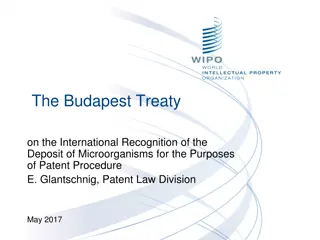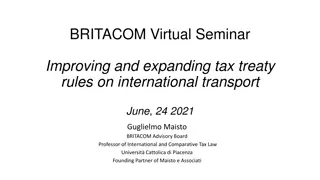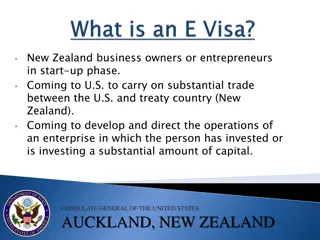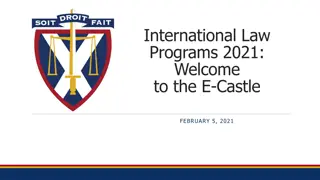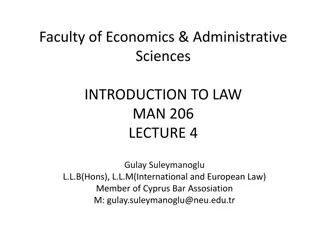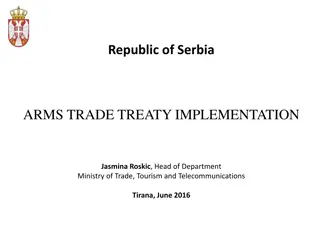Understanding Private International Law: Key Principles and Treaty Regimes
This lesson delves into the sources, key principles, and treaty regimes of private international law. It covers jurisdictional competence, conflicts of law, recognition of foreign judgments, Canadian common law vs. Quebec civil law, Hague Conventions, and the United Nations Convention on Contracts for the International Sale of Goods. Private international law plays a crucial role in resolving disputes with foreign elements and regulating international trade relationships.
- Private International Law
- Jurisdictional Competence
- Conflicts of Law
- Treaty Regimes
- International Trade
Download Presentation

Please find below an Image/Link to download the presentation.
The content on the website is provided AS IS for your information and personal use only. It may not be sold, licensed, or shared on other websites without obtaining consent from the author. Download presentation by click this link. If you encounter any issues during the download, it is possible that the publisher has removed the file from their server.
E N D
Presentation Transcript
Lesson 2: Sources of Private International Law
Lesson 2A: Key Principles of Private International Law The function of Private International Law is primarily to determine the following: 1) The court having jurisdictional competence to resolve a dispute having foreign elements (i.e. conflicts of jurisdiction). 2) The law applicable to resolve the dispute in the presence of a conflict of law, real or potential (i.e. legislative competence). 3) The rules governing the recognition and execution of foreign judgments.
Lesson 2A: Key Principles of Private International Law Canadian common law conflict of laws vs. Quebec civil law private international law Unlike the Common Law (CL) provinces in Canada, Quebec has a complete system of private international law contained in the Civil Code of Quebec and the Code of Civil Procedure. Contrary to CL, civil law favoursa theoretical and systematic codification of the entire subject. Despite the fact that the Civil Code contains a complete system of private international law there are several Federal Statutes which supplement the Civil Code. For example, the State Immunity Act governs the question of whether a foreign state is immune from the jurisdiction of any court in Canada.
Lesson 2B: Principal Treaty Regimes One of the most widely adopted and successful of the Hague Conventions is the Convention on the Service Abroad of Judicial and Extrajudicial Documents in Civil or Commercial Matters, more commonly called the Hague Service Convention. The Hague Service Convention allows for service of judicial documents from one signatory state to another without recourse to consular and diplomatic channels, replacing the Letter Rogatory.
Lesson 2B: Principal Treaty Regimes The United Nations Convention on Contracts for the International Sale of Goods (1980) (CISG) is an attempt to create a uniform sales law by regulating the rights and obligations of buyers and sellers in international transactions for the sale of goods.
Lesson 2B: Principal Treaty Regimes The CISG is a widely accepted international convention. The CISG has been accepted by many of Canada s major trading partners, including the USA. The CISG is used by countries that account for about two-thirds of all world trade. In the European Community the CISG has become the de facto sales law. In numerous parts of the world, the rise in case law relying on the CISG indicates that the CISG is becoming much more established, and will increase in importance as international trade continues to grow.
Lesson 2B: Principal Treaty Regimes The CISG was implemented in Canada on May 1, 1992 and has also been legislated into law by all the provinces and territories. The applicable provisions adopting the CISG are: Federal legislation (International Sale of Goods Contracts Convention Act , S.C. 1991, c. 13). Quebec legislation (An Act Respecting the United Nations Convention on Contracts for the International Sale of Goods , R.S.Q., c. C-67.01).
Lesson 2B: Principal Treaty Regimes The Convention on the Recognition and Enforcement of Foreign Arbitral Awards (New York Convention) (1958) requires courts of contracting states to give effect to private agreements to arbitrate and to recognize and enforce arbitration awards made in other contracting states. The New York Convention is considered to be the foundational instrument for international arbitration and has been adopted by 142 of the 192 UN Member States, including Canada.
Lesson 2B: Principal Treaty Regimes Although not a convention, the United Nations Commission on International Trade Law (UNCITRAL) developed a model law to assist States in reforming and modernizing their laws on arbitral procedure. This model law reflects worldwide consensus on key aspects of international arbitration practice that have been accepted by States of all regions and the different legal or economic systems of the world. The UNCITRAL model law has been used in Canadian legal proceedings.
Lesson 2B: Principal Treaty Regimes The Hague Convention on the Civil Aspects of International Child Abduction is a widely adopted and successful convention with 82 signatory states, including Canada. It provides for an expeditious method to return a child taken from one member nation to another. The Convention was drafted to ensure the prompt return of children who have been abducted from their country of habitual residence or wrongfully retained in a contracting state not their country of habitual residence.
Lesson 2B: Principal Treaty Regimes The Hague Convention on Protection of Children and Co- operation in Respect of Intercountry Adoption is another widely adopted convention with 81 contracting states, including Canada. It deals with international adoption, child laundering, and child trafficking. The main objectives include establishing safeguards to ensure that intercountry adoptions take place in the best interests of the child and with respect for his or her fundamental rights. It also establishes a system of cooperation amongst Contracting States to ensure that those safeguards are respected and thereby prevent the abduction, the sale of, or traffic in children.
Lesson 2C: General Principles as a Source of Private International Law A central principle of Private International Law is lex mercatoria, which refers to a body of rules and principles laid down by merchants themselves to regulate their dealings. In international commercial law and arbitration, lex mercatoria is seen as the foundation of such cornerstone principles of international commercial arbitration as efficiency, party autonomy, and choice of arbitrator. Arbitrators often render judgments based on customs such as lex mercatoria.
Lesson 2C: General Principles as a Source of Private International Law There is a very strong movement towards uniformisation in private international law, especially with regards to international commercial law. Examples of such attempts can be seen in the CISG and UNCITRAL model laws.
Lesson 2 Summary In this Lesson, you learned that Private International Law serves to determine: 1) The court having jurisdictional competence to resolve a dispute having foreign elements; 2) The law applicable to resolve the dispute in the presence of a conflict of law; and 3) The rules governing the recognition and execution of foreign judgments. You learned that the main source of private international law in Quebec is contained in the Civil Code of Quebec, and that there are also several Federal statutes which supplement the Civil Code. In addition, you learned that there is an array of international treaties and conventions covering a broad spectrum of areas of law which also apply to Quebec and Canadian private international law. Finally, you learned that family law, especially regarding international child relocation and child abduction, is another area where private international law is likely to be seen by a practitioner.












